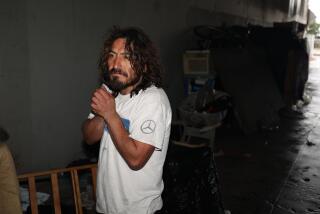Deaths of Two Homeless Linked to Nighttime Cold
Cold temperatures gripped Southern California for the third straight night Saturday, the continuation of an unusual chill that has apparently caused two hypothermia deaths among Los Angelesâ homeless while threatening farmersâ crops and sending city dwellers scurrying for hand warmers and furs.
The deaths were reported one day after the City Council declined to act on a proposal to open city buildings to the homeless and Mayor Tom Bradley appealed to the public to donate blankets to help keep them warm. The deaths prompted bitter accusations Saturday that the city isnât doing enough to feed and shelter homeless people during the cold spell, which began Thursday and is expected to continue for several days.
Police Saturday said a woman in her mid-30s, who was found lying on a Chinatown sidewalk, died Friday at French Hospital of a heart attack brought on by hypothermia. The woman, whose name was not released, was dressed in light clothing in the near-freezing temperatures.
A second transient, who was sleeping under a tree in Hansen Dam Park in Pacoima, was found dead Friday morning, apparently of exposure, police said. Several witnesses, who were camped in trailers at the park, said the man was intoxicated and refused shelter with them, said Lt. Maurice Rubio.
Autopsies were still pending and the cause of each death had not been officially determined by coronerâs investigators.
âItâs unconscionable that two people have died,â Councilman Ernani Bernardi, who was unsuccessful in getting the council to open public buildings, said Saturday. âGood Lord, the city takes on liability every time a person walks into a public building, so thereâs no reason we couldnât open some of these buildings until this cold spell is over.â
Blankets Called Inadequate
âWe are holding Mayor Bradley and the City Council accountable,â Susan Gosman, a spokeswoman for the Los Angeles Union of the Homeless, said of the deaths. âItâs callous to suggest that a blanket is truly going to save somebody living on the street in this weather.â The union and members of Tent City held a vigil on the City Hall steps Saturday evening for the two homeless people who died. Some protested the cityâs refusal to open buildings to house those who have been unable to get into crowded downtown missions.
âI intend to run for councilman and change things,â said Steven Williams, 28, shivering under a thin pink blanket. Williams, who said he has been homeless for two years, sang spirituals to rally fellow protesters.
Bradley said Friday that the city could not offer shelter because of problems involving liability and safety. Bradley maintained that the city has spent $50 million in the last two years to help the homeless, but some volunteer groups estimate that only 10,000 of the more than 50,000 homeless have places to stay at any one time.
According to the National Weather Service, slightly warmer temperatures are on the way, as the low-pressure air mass that has chilled the area migrates eastward, and a high-pressure system building over the Pacific Northwest moves in its place.
Meteorologist Mark McKinley said temperatures would rise several degrees each day through midweek, as warm Santa Ana winds begin to blow across Southern California on Monday. Daytime temperatures should be near the mid-60s today. The high temperature Saturday in Santa Ana was 60. The downtown high
But night temperatures will continue to drop to the mid-30s in Orange County and to the 20s and teens in the inland valleys and outlying agricultural areas for the next several days.
Saturdayâs low in Santa Ana was 33--well above the record low of 29 recorded for that date in 1955. The temperature dropped to 25 in Ojai, 26 in Ontario, 22 in Hemet, 26 in Santa Barbara and 12 in Lancaster.
Southern California Gas Co. reported that customers set a Saturday use record by burning more than 4.6 billion cubic feet of natural gas.
Water Pipe Rupture
Cold weather was also blamed for the rupture of a large water pipe that flooded homes in Canyon Country Saturday, fire officials said. Several homes had to be evacuated at dawn when the pipe coming from a 2-million-gallon water tank ruptured.
The weather was a boon for some businesses, which reported brisk sales of everything from car batteries to mittens, but a peril to farmers, who were working to save their crops.
In Fullerton, the manager of Loma Vista Nursery estimated his loss at $20,000 after cold weather damaged much of his stock. In Westminster, a strawberry grower lost six acres of fruit to the frosty temperatures.
Citrus growers throughout Southern California were carefully monitoring the coldâs effects on their crops, which they hoped to save from frost by using large fans and heaters. A spokesman for the citrus growers said it would be several days before the damage could be assessed.
In contrast, business was booming for winter clothing outlets, which reported a surge in demand for items many Southern Californians do not own--warm gloves, hats and mittens.
Arctic Gloves
âPeople are really going for leather, and I mean the real warm, Arctic type of gloves,â said Glendale Sportmartâs manager John Schmidt. âIâm from back East, so itâs pretty amazing to me to see what people out here think is cold.â
Others found a way to warm up, California-style.
Nora Sullivan, assistant manager of Tanning Plus in Studio City, said her company was swamped with people seeking the comfort of artificial sunshine.
âThis winter weatherâs been just fabulous for us because when the cold hits they just flood in to escape it,â Sullivan said.
In Beverly Hills, people were fighting the frigid temperatures with fur.
Mike Tores, assistant manager of Flier Furs in Beverly Hills, said clients were pouring in to retrieve their stored minks, foxes and other fur coats.
Heavy Fur Coats
âEverybodyâs coming in to get them out because of the cold,â he said. âTheyâre picking up the heavy coats, the big ones, the long ones. They arenât taking any of the jackets or small pieces at all. Weâve been very busy.â
In stark contrast, Salvation Army volunteers were working along Skid Row to distribute more than 2,500 donated blankets, and to serve warm meals of lima beans, ham and sausage with thick slices of bread.
In Orange County, the homeless and hungry jammed shelters to stay out of the cold, and relief organizations were distributing blankets and food for those who could not find a bed for the night.
âNot much change, weâve still got quite a few guys here,â said John Wilson, a desk clerk at the Orange County Rescue Mission on West Walnut Street in Santa Ana, which has been filled to overflowing the past three nights.
âWeâve had people bringing by blankets, clothing, shoes, food and canned goods. . . . They can do that 24 hours a day.â
The Salvation Army Hospitality House on Third Street in Santa Ana also was full, and volunteers there were collecting blankets brought in from the organizationâs eight collection centers around the county. The centers will be open to accept donations today.
Volunteers also spent the night traveling the downtown Los Angeles streets in two vans distributing the blankets along with hot soup. Many of the homeless were huddled on streets over makeshift trash can fires, inside flimsy cardboard boxes and in doorways to get out of the chilling wind.
More than 100 blankets were delivered to the Ward A.M.E. Church in South Los Angeles, where church officials provided shelter and issued a challenge for other churches to do the same.
The demand for emergency shelter increased 50% in Los Angeles last year, the highest of 25 cities, according to a recent survey by the U.S. Conference of Mayors. The emergency hot line for Los Angeles County was unable to find housing for 42% of those who called last year, the study found. Ironically, researchers said, many of the homeless gravitate to Los Angeles because of its usually balmy weather.
Councilman Bernardi noted that one possible answer would be to follow a program adopted in New York City. When temperatures hit the low 30s, the city sends buses throughout the city to forcefully take homeless people to shelters.
He added that, âunfortunately,â deaths from cold are not unusual. There were at least seven last winter, according to police records, he said. He added that the city was willing to spend $30,000 for insurance and thousands more for police protection for the cityâs annual Street Scene music festival.
âBut the real street scene,â he said, âis the plight of the homeless who canât help themselves.â
Times staff writers Alan Goldstein and Robert Schwartz contributed to this story.
More to Read
Sign up for Essential California
The most important California stories and recommendations in your inbox every morning.
You may occasionally receive promotional content from the Los Angeles Times.










